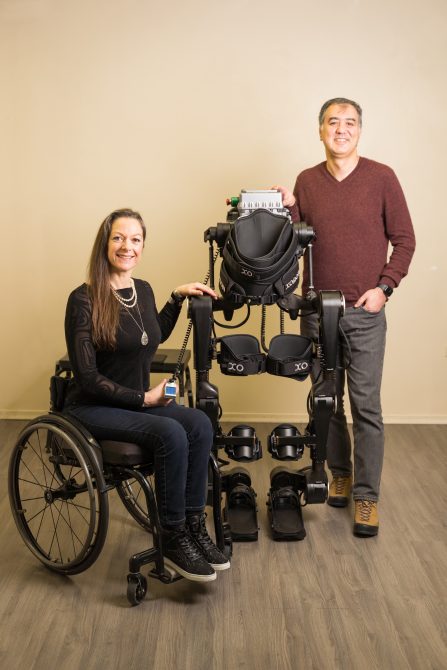
Wearable robot aims to free patients from wheelchairs
By Sohail Kamal, West Coast Correspondent
Electronics Medical Wearable Technology Editor Pick robotics wearableBC-based Human in Motion Robotics awarded $663K contract by Innovative Solutions Canada
Human in Motion Robotics Inc. (HMR) is a Vancouver-based developer of a next generation wearable lower-limb exoskeleton called XoMotion. Designed to revolutionize robotic rehabilitation, the medical unit supports physical therapy in order to get people out of wheelchairs and walking again with full mobility and independence.
XoMotion also provides advanced articulation and superior joint range of motion, allowing for natural walking, self-balancing and independent use. West Tech Report recently had the opportunity to chat with company co-founder and CEO Siamak Arzanpour about the firm’s recent contract with the Canadian Federal Government – why they started the company, and how their solutions will help people get out of wheelchairs.

B.C. fashion designer Cloe Angus (left) helped advise Human in Motion Robotics Inc. co-founder & CEO Siamak Arzanpour in the design of XoMotion next generation exoskeleton.
HMR was also recently awarded a CAD$663,000 contract by Innovative Solutions Canada (ISC) for the Department of National Defence Canada (DND). The contract is for the Canadian government to purchase two XoMotion units. The wearable robot is designed to get people out of wheelchairs and walking again with full mobility and independence.
Hands-free dynamic walking
“HMR’s patented and disruptive medical technology offers a dramatic improvement in mobility challenged persons’ rehabilitation in clinics or daily living at home with a host of distinguishing and innovative features,” explains Arzanpour. “It is essentially a self-balancing bipedal robot capable of hands-free dynamic walking and other complex maneuvers for daily use for mobility-impaired people. For people with motion disabilities, it is not their destiny to sit in a chair for the rest of their lives. It’s almost a social justice issue.”
The impetus for starting the company came from an ‘Abilities Expo’, which showcased mobility products. The founder witnessed the excitement of wheelchair users, especially “when they saw one of their own stand up and walk,” says Arzanpour. HMR today is the result of more than a decade of research and development in the area of robotic systems and design of related sophisticated mechanisms by the HMR co-founders.
Self-balancing exoskeletons
“I began to take note of the significant limitations of the existing technology, most specifically the single motion of walking forward that it supports and the requirement for arm support including walkers, canes, and crutches,” says Arzanpour. He was convinced there was a better approach and subsequently contacted a colleague, Dr. Edward Park, who had recently published a scientific journal article about self-balancing exoskeletons.
Together, with support from Simon Fraser University (SFU), they incorporated HMR to develop the next-generation exoskeleton that would remove the need for arm supports, remove the need for a person to be alongside or behind the exoskeleton user, and provide a natural human gait.
One early example of product success came by way of a local fashion designer, Chloe Angus, who was told in 2015 that she would never walk again. Refusing to accept this answer, Angus met with HMR first at SFU. When it was explained to her that they were developing the next-generation exoskeleton that would overcome the limitations of prior iterations she had tested, she agreed to join as an advisor to HMR. Her goal was to ensure that what was being developed would be directly applicable to those with lower-limb paralysis similar to her situation.
Engineering behind these products is complex
At present HMR is focused on two new product lines: XoMotion-R for rehabilitation and XoMotion-P adapted for personal and home use. The target customers for the XoMotion-R will be institutions like hospitals and rehabilitation centres whereas the XoMotion-P will be marketed to consumers and end users. The engineering behind these products is complex.
“It has 12 motors that are working synchronously together to generate stable and natural gaits. The brain of the robot should generate commands for the motors and the motors should execute them in milliseconds, otherwise, the robot will not walk smoothly and it may fall,” says Arzanpour.
All the components of this robot including the motors are designed by the HMR team, which resulted in a sleek product, appealing to end-users. HMR also custom designs its batteries and chargers for the robots, and worked with manufacturers to cut weight on the device and minimize charging time.
The contract with the federal government will lead to the delivery of the XoMotion-R to a clinical testing site at the Queen Elizabeth Hospital in Charlottetown, Prince Edward Island.
